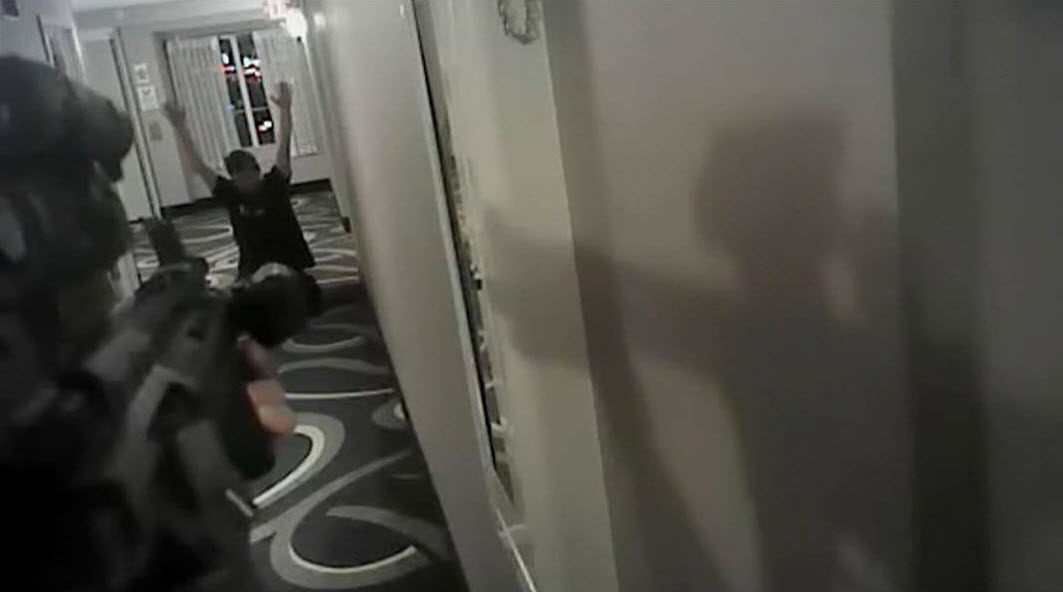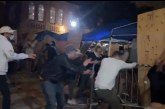
If you missed the news, Michael Slager, the North Charleston, South Carolina, police officer who shot and killed Walter Scott, received a 20-year sentence this week. In an era that began in August of 2014 with the deaths of Michael Brown and Eric Garner, this is a momentous occasion, but also an anomaly.
The Vanguard has been reporting on police misconduct and officer involved killings since its 2006 founding, and there are clearly different levels of incidents – Mr. Slager’s actions were as egregious as they come.
The incident which began as a traffic stop escalated, and Mr. Scott was running away when he was shot in the back and killed. Mr. Slager lied about it, unaware that the incident was caught on video. The video showed that Slager had no reasonable fear for his life and fabricated an account of Mr. Scott taking his Taser.
Still, with all of this evidence caught on video, state prosecutors were not able to convict him.
As Washington Post columnist Radley Balko pointed out in a column this week: “This is one of the few times a police officer has ever been held criminally accountable for an on-duty shooting. But Slager’s is not a story about accountability, or about fair justice.”
He also pointed out – I think quite correctly – that Mr. Slager made “a strategic mistake” when he agreed to plead guilty on the federal civil rights charges.
Writes Mr. Balko: “I’m not at all convinced that a jury would have convicted him in federal court, either. Juries just don’t like to convict cops.”
We have seen this time and time again. Even in cases where there appeared to be no justification for the killing such as with Philando Castille, the jury has generally acquitted.
This week alone, a former Arizona police officer was acquitted after shooting and killing unarmed Daniel Shaver.
Mr. Shaver was certainly careless in creating the situation that led to his death, but by all accounts he was compliant. The facts, as laid out in a December 3 article in the Atlantic suggest that in January of 2016, Mr. Shaver was at a motel in Mesa Arizona, and he was drinking heavily when he showed two other guests his pellet gun.
“Down below, two motel guests in the La Quinta Inn and Suites hot tub looked up and saw a man with a gun near a fifth-floor window. Someone called 911,” the article reports. “By the time six police officers gathered in the fifth-floor hallway, Daniel Shaver was intoxicated.”
The occupants of the room, heavily intoxicated and confused, were ordered out of the room by the police.
However, when Mr. Shaver exited he was reportedly unarmed, had his hands up and did his best to comply with the demands of police, who ordered him to lie on the ground.
Former Officer Philip Brailsford, just 26 years old, then shot and killed him. Mr. Brailsford faced second-degree murder, but this week was acquitted.
When the original article came out, the body-cam footage had not been released. Now, however, that video is available (hit this link and scroll down).
Conor Friedersdorf of the Atlantic writes: “It is difficult to watch. But this is the footage that jurors reviewed in the case, and if the public wants to diminish the likelihood of shootings like this one, ordinary citizens will need to grapple with what it depicts.”
Mark Geragos, an attorney in the case, describes the body-cam footage, which had been shown in court but not released to the public at the time:
“I know why they have not released it. It’s not bloody. It’s the most chilling, horrific thing you’ve seen in your life. This kid was begging for his life. He raised his hands, did everything the cops told him to do. And then they just executed him. It’s bone chilling. One of the worst experiences I’ve ever had in my life is sitting in a court room with his widow, who watched it for the second time, and she literally went into convulsions. I had to grab her to hold her in a bear hug. It was just awful.
“Ben has been with me for eight years and does nothing but the civil-rights practice. I’ve been doing criminal and civil rights for 35 years. I’ve seen thousands of tapes. This is light years beyond anything I’ve ever seen … it burns a hole in your brain. I literally had nightmares about it.”
Mr. Friedersdorf also quotes from an “incident report produced by a Mesa police officer, who watched the body-cam footage of the encounter and described what happened from beginning to end. Throughout the events about to be described, Daniel Shaver is totally unarmed, and wearing basketball shorts and a t-shirt:”
Long excerpt from the incident report written by a Mesa police officer who watched the body-cam footage and described what occurred from beginning to end:
Shaver could be partially seen walking from the alcove into the hallway a split second after Sgt. Langley shouted for them to stop. Shaver raised his hands in the air prior to any further command, round the alcove into the hallway and immediately dropped to his knees with his hands in the air facing the officers … Sgt. Lanley shouted for both of them to get on the ground. Shaver placed his hands in front of him and laid down on the ground on the south side of the hallway with his hands extended above his head. In the video, Shaver appeared to be wearing a dark colored shirt and dark shorts. No weapon was visible in the video, but also it was not clear Shaver did not have a weapon from the camera view. Shaver was, however, obviously compliant and offered no resistance at that point.
Sgt. Langley asked Shaver if there was anyone else in the room and Shaver answered that there was no one else in the room … Sgt. Langley then calmly asked if both of them could understand him … Sgt. Langley then stated, “Alright, if you make another mistake, there is a very severe possibility you are both going to get shot, do you understand?”
Shaver responded “Yes” to this question … Sgt. Langley then began to talk when Shaver started to ask a question by saying “What’s––”. Sgt. Langley told Shaver to shut up and stated that he was not there to be tactful and diplomatic with Shaver and they need to obey his commands. At that point, Shaver’s outstretched arms had both palms facing up so the officers could see his hands. As Sgt. Langley was saying they needed to obey his commands. Shaver moved both his arms in front of his face in a similar manner to what would occur when someone is lying on their stomach and intending to rest their head in their crossed arms. Sgt. Langley took note of this and asked Shaver if he had told Shaver to move. Shaver immediately moved his hand back out in front of him with his palms facing up and said, “I’m sorry. No, sir.”
Sgt. Langley then ordered Shaver to place his hands on the back of his head and interlace his fingers. Shaver was again compliant. Sgt. Langley then told Shaver to cross his left foot over his right foot. Shaver complied with this but appeared confused as to which foot Sgt. Langley had ordered him to cross. He crossed his feet both ways before finally crossing his feet as Sgt. Langley had instructed. Sgt. Langley then asked again who else was in the room and Shaver responded with “nobody.”
Sgt. Langley then asked if both of them were drunk and they both responded that they were not … He then told Shaver that he turn his eyes down and look at the carpet and not move. He further instructed that Shaver needed to keep his fingers interlaced on his head and his legs crossed. Sgt. Langley then told Shaver that if he moved, it would be considered a threat and the officers would have to deal with that and Shaver “may not survive it.” Shaver acknowledged with “yes sir” when asked if he understood this.
Shaver remained compliant and was not moving … Sgt. Langley told Shaver to listen to his instructions and “do not make a mistake.” Portillo’s purse was clearly visible in the middle of the hallway approximately three feet in front of Shaver.
Sgt. Langley told Shaver to keep his legs crossed and to place his hands out in front of him and push himself up into a kneeling position. Shaver moved his hands in front of him and then when he started to push himself into a kneeling position, he uncrossed his legs. Sgt. Langley immediately shouted at Shaver to keep his legs crossed. Shaver crossed his legs and was now on all fours on his hands and knees on the floor. Shaver’s head was down and he could be heard saying he is sorry and continued to mumble something I could not understand. Shaver then attempted to raise his body into a kneeling position as he had originally been instructed and brought both of his hands behind his back. This did not appear to be an exaggerated movement and looked similar from the vantage point of the video as when someone is handcuffed with officers behind them.
Sgt. Langley began to tell Shaver that he was not interested in a conversation as Shaver pushed himself up and placed his hands behind his back. Sgt. Langley stopped mid-sentence and began loudly screaming at Shaver about his hands. The initial command of what to do with his hands was loud and indiscernible on the recording as to what is being asked of Shaver. Sgt. Langley then followed up with shouting for Shaver to place his hands in the air. Shaver complied and rapidly put his hands above his head.
At approximately 16 minutes and 40 seconds on the recording Sgt. Langley shouted at Shaver, “If you do that again, we are shooting you. Do you understand?” Shaver immediately responded with the statement, “No, please don’t shoot me.” Shaver’s voice appeared to be panicked and Sgt. Langley shouted that Shaver needs to listen to instructions. At that point, Shaver’s arms were above his head with his elbows at approximately 90 degree angles. Shaver was ordered to put his hands in the air again by Sgt. Langley and he pushed his hands high above his head in compliance.
Sgt. Langley then shouted to Shaver that he was to keep his hands high in the air and that if he puts them in the small of his back again that they will shoot him. Shaver could audibly be heard sobbing at that point and Sgt. Langley asked if he understood. Shaver again said, “Yes, sir,” but could now be audibly heard sobbing as he said this.
Sgt. Langley could then be heard telling Shaver to crawl towards him. Sgt. Langley shouted this command and Shaver again dropped to his hands and knees and again can audibly be heard sobbing “Yes, sir,” as he began to crawl forward. Shaver reached the area where Portillo’s purse was and his left hand moved across his body and around the purse in order to crawl past it. Shaver was audibly sobbing as he crawled. Officer Brailsford’s rifle was primarily pointed down the hall until this movement was made. Officer Brailsford then swung his rifle back towards Shaver where Shaver could be seen with his braced left hand and his right hand moving back towards his waist with his elbow raised behind him. Shaver’s head appeared to be down with his face looking at the carpet. What appeared to be multiple voices, including Sgt. Langley’s, then began to say “Don’t” as Shaver’s hand moved back toward the front of his body. When his hand moves toward the front it is very slightly balled and his thumb is towards the top. Officer Brailsford fired his first shot as Shaver’s hand was moving toward the front of his body and as at least one officer was heard saying, “Don’t.”
Writes Mr. Friederdorf: The incident report recounts that “the movement of Shaver’s right arm in the recording was a very similar motion to someone drawing a pistol from their waist band. Officer Brailsford rapidly fired five shots at Shaver and Shaver slumps to the ground on Portillo’s purse. Shaver’s underwear were clearly visible and it appeared his shorts had fallen partially down his legs at that point. Shaver’s motion was also consistent with attempting to pull his shorts up as they were falling off. No other purposes for this movement appear to be viable.”
As he reports, “only one of the six police officers chose to shoot.”
The jury acquitted Mr. Brailsford. They acquitted him of second-degree murder in less than six hours of deliberation and they acquitted him of the lesser charge of reckless manslaughter.
I agree with Mr. Balko, Officer Slager should have taken his chances with a federal jury. He might have won.
—David M. Greenwald reporting







The video of Daniel Shaver being killed is beyond chilling. I first saw it a couple of nights ago, on one of the network news channels.